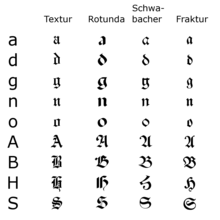
Back Fraktur Breton Fraktur Catalan Fraktura (písmo) Czech Fraktur (typografi) Danish Fraktur (Schrift) German Fraktura (pismo) DSB Frakturo (skribo) Esperanto Fraktur Spanish Fraktuur Estonian Fraktuura Finnish
| Latin script (Fraktur hand) | |
|---|---|
 | |
| Script type | |
Time period | 16th–20th centuries |
| Direction | Left-to-right |
| Languages | German[a] and some other European languages |
| Related scripts | |
Parent systems | Blackletter
|
Child systems | Kurrentschrift, including Sütterlin |
Sister systems | See Blackletter |
| ISO 15924 | |
| ISO 15924 | Latf (217), Latin (Fraktur variant) |
| Unicode | |
0020–00FF[b] | |
| |

Fraktur (German: [fʁakˈtuːɐ̯] ⓘ) is a calligraphic hand of the Latin alphabet and any of several blackletter typefaces derived from this hand. It is designed such that the beginnings and ends of the individual strokes that make up each letter will be clearly visible, and often emphasized; in this way it is often contrasted with the curves of the Antiqua (common) typefaces where the letters are designed to flow and strokes connect together in a continuous fashion. The word "Fraktur" derives from Latin frāctūra ("a break"), built from frāctus, passive participle of frangere ("to break"), which is also the root for the English word "fracture". In non-professional contexts, the term "Fraktur" is sometimes misused to refer to all blackletter typefaces – while Fraktur typefaces do fall under that category, not all blackletter typefaces exhibit the Fraktur characteristics described above.[a]
Fraktur is often characterized as "the German typeface", as it remained popular in Germany and much of Eastern Europe far longer than elsewhere. Beginning in the 19th century, the use of Fraktur versus Antiqua (seen as modern) was the subject of controversy in Germany. The Antiqua–Fraktur dispute continued until 1941, when the Nazi government banned Fraktur typefaces. After Nazi Germany fell in 1945, Fraktur was unbanned, but it failed to regain widespread popularity.
Cite error: There are <ref group=lower-alpha> tags or {{efn}} templates on this page, but the references will not show without a {{reflist|group=lower-alpha}} template or {{notelist}} template (see the help page).